Carlevaro Technique
Position Change, Sectors of the Fingerboard
The Concept of Position
The length and width of the neck of the modern classical guitar pose certain peculiar difficulties not shared by other stringed instruments with similar but smaller fingerboards. A musical passage on the classical guitar may require that the left hand change position from one end of the fingerboard to the other. The index is the point of reference and guide for these position changes.
When changing position on the fingerboard, the left hand enters its most unstable state. That is why the classical guitar player ought to practice displacements on the fingerboard very attentively. It is here that most mistakes happen and every effort that you invest in mastering changes of position on the fingerboard will be one of your best "technique investments".
Changes of position also generate psychological instability because the brain elevates its degree of anxiety in the proximity of a position change. Therefore, it is a multiple challenge situation that only steady and perseverant practice can overcome. Typically, the best thing you can do before a change in position is to augment your relaxation and trust your hands to do the best work.
The index has a natural ability to orient. Without orientation it would be impossible to move swiftly along the fingerboard, especially when trying to avoid strings squeaks.
String squeaks will always put the tag on a defective left hand technique and/or musicianship. The modern guitar player can no longer hide behind the phrase "...well, Segovia made lots of left hand squeaks...". For one thing this is only partially true since at a point in his career (1950s- 60s) his left hand was very silent. Because of his long life and career he had the chance to adjust his technique several times throughout the years. It is in this early 20th century span of time that Andres Segovia lived in Montevideo. That is when Carlevaro started observing the master from very close and he started working on his epic technique compendium. He took the best from the Spanish master and described it and at the same time he corrected what he considered technical & aesthetical monstrosities.
Close cooperation between the wrist and the arm is absolutely necessary when performing changes of position.
Position will be defined as the location of the left hand in relation to the frets on the fingerboard. If the first finger is placed at the first fret, the hand is said to be in first position; if finger 1 is at the third fret, the hand is in third position, and so on.
If finger 1 stops the e B at the 4th fret of the G string the hand is said to be in fourth position, whereas playing the same note with finger 2 indicates that we are in position 3.
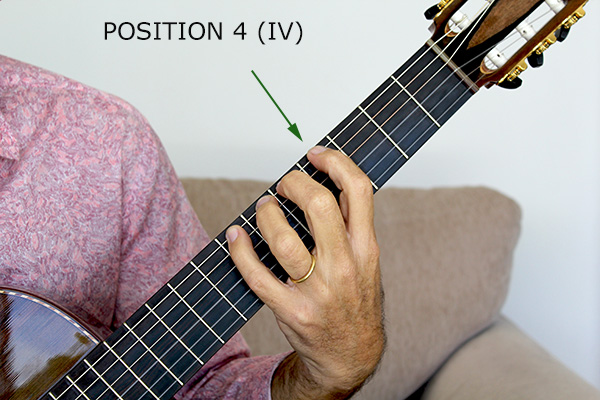
I use Roman numerals alone (or under an inverted L) to indicate the position on the fingerboard.

Note that finger 1 always determines the position even when it is not being used on the fingerboard.
A change of position will be referred to as a translation. The arm is responsible for the changes in position or translations. The fingers have no part in the translation: only after the arm has completed the task the fingers are placed on the fingerboard where they do their work.
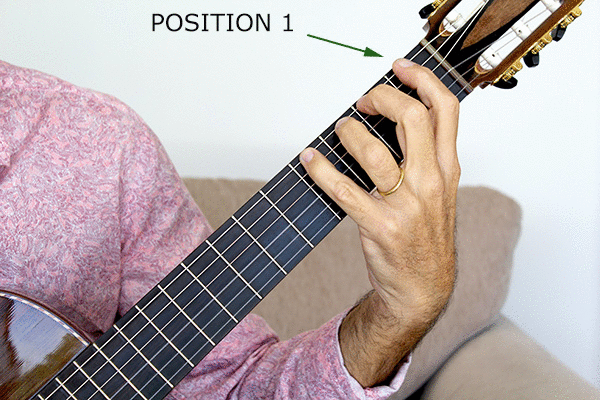
As the arm is changing the position, the fingers adjust the angular separations between them in midair.
Before actually beginning a translation, the fingers must first lift from the strings (The arm does this with a push. If the fingers simply relax, they will squeak with the string because the angular separations will be neutralized resulting in a side motion against the winding of the strings). These ugly noises are the normal outcome when we ignore this crucial step: the arm must remove the fingers perpendicularly from the fingerboard. This motion is almost imperceptible to the eye; but it is there nevertheless.
Gliding from note to note on the same string is only acceptable when the music calls for it (glissando, portamento). It will always be unacceptable when we use it to cover our technical insecurities. If we do not polish our technique, the music will suffer.
Just how do the fingers perform during a change of position? The answer is: they simply do not perform. Upon releasing their pressure from the string, they momentarily enter into a state of relaxation (the same can be said of the LH thumb). The fingers must in no way interfere with the functions of the arm but rather allow themselves obediently to be lifted (perpendicularly) by the arm from the fingerboard before being transported immediately afterwards to their new location.
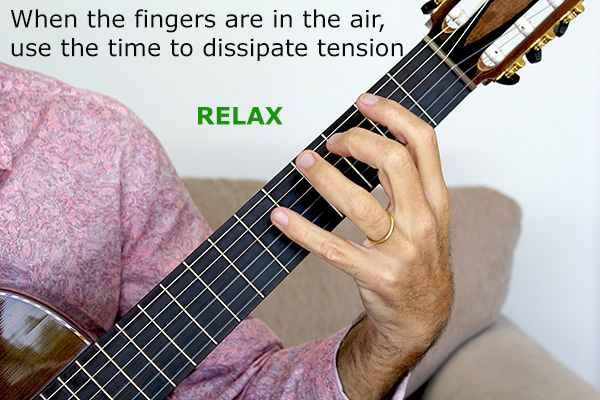
The following exercise is one you should add to your practice schedule until you understand the mechanics involved in position change and the concept of pivot. Look at the video closely and observe how the fingers are lifted by the arm and the position change is done by the arm while the fingers prepare for the new position in midair.
The exercise will reinforce the position of notes on the fretboard since you will be playing one note in different positions with every round.
The elbow is kept close to the body. Finger 3 works as a pivot. Finally, no left hand squeaks are produced by the changes. Bring up the speed gradually and go down the fretboard to position 7 (B).

Left hand translations on the fingerboard can be grouped into three different categories: by substitution, by displacement, and by jump.
1. Translation by Substitution
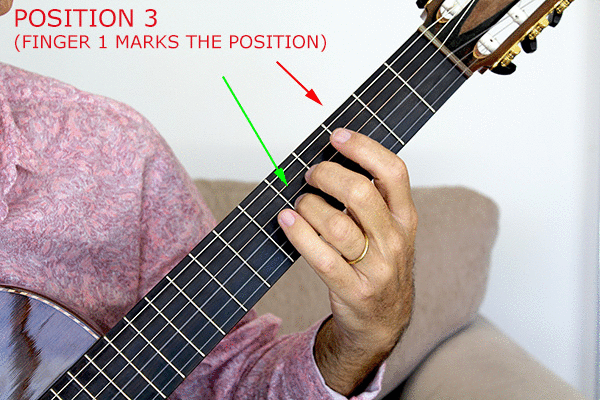
A change of position by the hand involving the substitution of one finger (or fingers) by another at the same fret. This type of substitution is used for translations to nearby positions. The "element in common" here is the fret.
2. Translation by Displacement
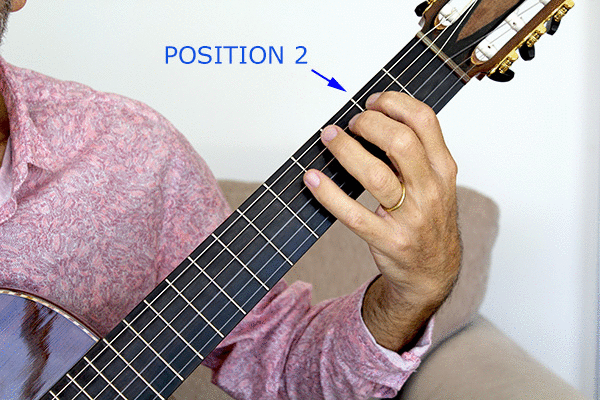
The same finger(s) is (are) moved to a new position.
This type of substitution is used for translations to nearby positions or distant positions. A distant position is one that goes beyond the normal range of the four LH fingers. The element in common here is one or more fingers.
3. Translations by Jump.
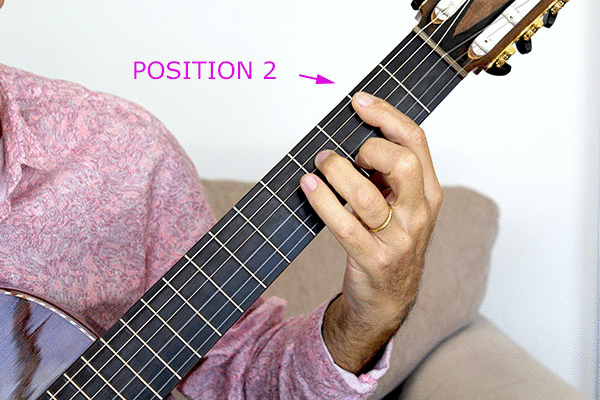
The hand jumps from a position to another beyond the 4 fingers range of the LH fingers. No element in common.
Sectors of the Fingerboard
The fingerboard can be divided into three sectors:
1. First octave ranges from the first to the ninth position. Finger 4 reaches the 12th fret (octave). Mechanics: The arm can perform the translations unhindered. The LH thumb follows naturally.
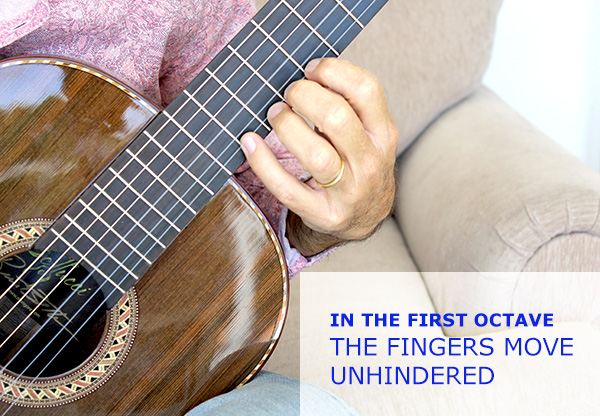
2. Transition: Positions X, XI, and XII.
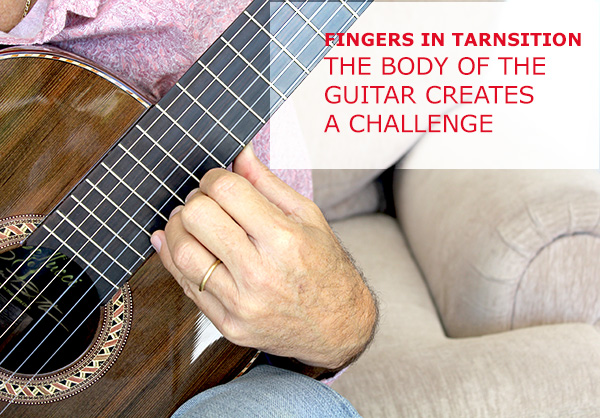
Mechanics: Unless you use a guitar with the Cutaway or an elevated fingerboard, the hand is challenged by the lower side of the guitar. The challenge can be overcome if the arm is brought a little forward and the shoulder is lowered slightly. The thumb moves downward.
The continuation of this class is in the members area, become a member today.
 Back to Top
Back to Top
